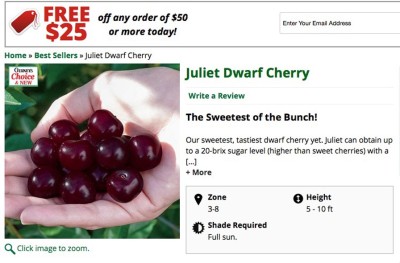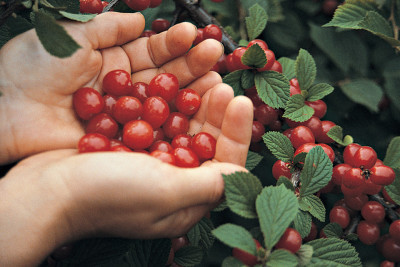CHERRIES JUBILEE (I HOPE)
More Plants?!?!?!
You’d think, after decades of gardening in the same place, that I by now would have planted every tree, shrub, and vine I could ever want or have space for. Not so! Every year I make up a “Plants to order” list, unfortunately before I hone down just where I’ll sink my shovel into the ground to prepare a planting hole.
Topping my list was Carmine Jewel cherry, a tart cherry that’s also good fresh. (Tart cherries often have higher sugar levels than do sweet cherries; but they also have tartness and other flavors that offset that sweetness.) The biggest draw for Carmine Jewel is its stature — no more, at maturity than 6 or 7 feet high. And a bush, not a grafted tree, so that if cold or deer nip back branches, new sprouts from ground level bear the same cherries that the rest of the bush does or did.
As a bush, Carmine Jewel is easy to net against birds, and easy to harvest. One big unknown is pest resistance and its flavor — that is, whether or not I will like it.
Some research indicated that Carmine Jewell is a hybrid of Prunus cerasus, which is the genus for conventional tart cherries, and P. fruticosa, a hardly edible cherry that offers bushiness to its offspring. It’s often listed, botanically, as P. X kerrasis, after Dr. Kerr who started this breeding line way back in the 1940s.
Carmine No, Juliet Yes
One benefit — to me — of this weekly column is that it forces me to research more deeply topics or plants that I might otherwise gloss over. Said research this week makes me cross Carmine Jewel off my “Plants to order” list.
Carmine Jewel, it turns out, has siblings. Among its siblings, it’s one of most tart. A newer group of siblings, the Romance series, were born in 2004, whose fruits are larger and sweeter. From this group, the variety Juliet was very productive and the sweetest. (Romeo was also quite good, but not as sweet.) So Juliet it is for me.
It remains to be seen just how good Juliet tastes, and how resistant it is to common cherry pests.
Nanking Cherries, All Good
Between the first paragraph and now I’ve figured out where to make Juliet home — in the “available seat” in the row of Nanking cherries (Prunus tomentosa) that line my driveway. This position will also make easy comparisons with the Nankings, one of the most reliable, tasty, care-free, and ornamental cherries I grow.

Nanking cherries, easy, good, quick to bear, prolific
Nanking cherries, despite snowballs of pinkish white blossoms every year, sometimes followed by frosts, have never failed to offer more cherries than we could possibly eat. I prune the bushes only to keep them from swelling to their 10 foot high and wide full size. The only downside to the fruits is that they are small. But they’re so good they earned themselves a whole chapter in my book Uncommon Fruits for Every Garden.
Choke(!)berry, Maybe
I recently learned that I may qualify to wear a longsleeve, blue T-shirt emblazoned with a large S. The S won’t stand for Superman, but for Supertaster. I sifted out this information with another fruit bush that was on my “plants to order” list: chokeberry (Aronia melanocarpa).
About twenty years ago I planted a chokeberry bush. It fruited rather quickly, I tasted the fruit, spat it out, and dug up the plant.
A few weeks ago I was talking with a young farmer and after agreeing on the delectable flavor of black currants, he mentioned that chokeberry was another of his favorite fruits. “They’re awful,” said I. “Not if they’re cooked, frozen, or dried,” said he. Hmmm . . . chokeberry’s bite is from astringency, which, does dissipate when certain fruits — persimmons, for example — are cooked, frozen, or dried. Perhaps chokeberry needs a second chance here.
Then I started reading about supertasters, whose palates can be very sensitive to certain organoleptic sensations — astringency, for instance. I must be a supertaster because the slightest amount of astringency induces my spit reflex (which is why I grow Mohler and Szukis persimmon, both of which yield ripe fruits with hardly a hint of astringency). Reading more about chokeberry, it seems that those who like the fruit don’t mind, but actually enjoy, some astringency. So chokeberry is now on my “Plants to order, maybe” list.
Taste aside, chokeberry has much to recommend it. It’s a beautiful landscape bush, white blossoms in spring and, on many varieties, fiery red leaves in fall. It tolerates cold to below minus 30° F., and some shade. It’s also cosmopolitan about the soil in which it’s planted.
Chokeberry garners a lot of attention these days because its among the highest of any temperate zone fruit in both antioxidants and anthocyanins. The anthocyanins are one contributor to the astringency.


Am going to try Juliet this spring myself! Will order from HoneyberryUSA, a small farm in Minnesota that looks really interesting. Will also order some honeyberry plants from them (Aurora and Borealis), which have been on my “Plants to order” list for a while.
Had the same experience with chokeberries as you, but might give them a second chance if their astringency really does dissipate with freezing.
Thanks for another great blog entry. Very helpful.
I was also wondering about Aronia, after reading about it in foraging books. I bought a bag of unsweetened dried berries from amazon and found them pretty good. They basically have zero sugar, so while they are interesting to eat by themselves they really shine when you combine with some other fruit or food with some sweetness. We ended up eating most of them in pancakes. While I have not yet found any bushes growing wild, last fall I discovered some in a wild plant garden along the sidewalk by a school in nearby Arlington. I stopped there for handfuls of berries numerous times on the bike ride home from work. Though my sometimes riding companion didn’t care for them (we both ate lots of wild autumn olive…), I thought they were good enough to eat. Now that you mention it they are more astringent when fresh. I planted two Viking Aronia in my sideyard beneath some maples; not a good place but they are supposed to be pretty easy to grow. They got nearly destroyed by falling ice and snow last winter but are not dead yet, hopefully will bounce back and make some fruit in a couple years.
But do they taste GOOD?
I’m also interested if chokeberry astringency really does dissipate with freezing.
I found the Nanking cherry absolutely terrible….it is 90% pit, 9% meat and 1% skin. Not even worth harvesting if you can beat the rodents! In addition (not the fault of the tree) chipmunks practically strip the tree of all fruit before they ripen. I just prune these trees for any ornamental value I can get out of them. Awful, awful awful!!!
Your experience is very different from mine and that of many others who have grown the fruit. The fruit is small, but so is the pit. My bushes bear too heavily for any pest to make a dent in the crop. And, to me, at least, the flavor is excellent. Are you sure you are growing Nanking cherry?
Is there a place in Hudson valley that sells Nanking cherry bushes? Also, any luck on the Juliet bushes??
I’ll have some Nanking Cherries at my annual sale in May. Juliet, probably not. Romeo died. Juliet survived but hasn’t yet borne anything. I suspect, though, that it will be as pest-susceptible as any other cherry — except Nanking.